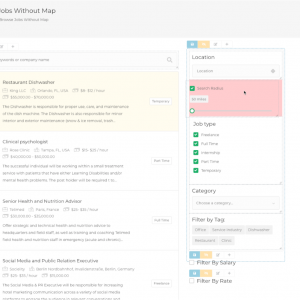functions.php
user_login ) . “rn”;
$message .= sprintf( __( ‘Password: %s’ ), $password ) . “rn”;
$message .= wp_login_url() . “rn”;
wp_mail( $user->user_email, sprintf( __( ‘[%s] Your username and password’ ), $blogname ), $message );
}
}
endif;
}
/**
* Set User Values (including password) from Submit Form
*
* Available values that can be set are:
* first_name, last_name, display_name, nickname, user_email, user_url, user_nicename, user_pass, description
*
* The key used inside the $_POST MUST be the exact meta key of the field you want to use for that value
*
* @param $new_user
*
* @return array
*/
function smyles_allow_set_password_from_submit_form( $new_user ) {
// Password
if( isset( $_POST[‘account_password’] ) ){
$new_user[‘user_pass’] = $_POST[‘account_password’];
}
// First Name
if( isset( $_POST[‘first_name’] ) ){
$new_user[‘first_name’] = $_POST[‘first_name’];
}
// Last Name
if( isset( $_POST[‘last_name’] ) ){
$new_user[‘last_name’] = $_POST[‘last_name’];
}
return $new_user;
}
// Change filter below to submit_resume_form_validate_fields if you’re using this for Resume submit instead of Job
add_filter( ‘submit_job_form_validate_fields’, ‘smyles_check_user_passwords’, 10, 3 );
/**
* Verify that both password fields match
*
* This function verifies that both password fields match, and returns an error if they
* do not. This assumes you created two password fields on the form, with the meta key of
* account_password and account_password2
*
*
*
* @param $true
* @param $fields
* @param $values
*
* @return WP_Error|boolean
*/
function smyles_check_user_passwords( $true, $fields, $values ){
if( isset( $_POST[‘account_password’], $_POST[‘account_password2’] ) ){
if( $_POST[‘account_password’] !== $_POST[‘account_password2’] ){
return new WP_Error( ‘validation-error’, __( ‘Passwords do not match, please try again.’ ) );
}
}
return $true;
}
functions.php
<?php
/**
* PLEASE NOTE THIS CODE IS UNTESTED AND IS ONLY MEANT TO BE USED AS A STARTING POINT !!!
*
* CODE STILL NEEDS TO BE ADDED TO REMOVE OR PREVENT THE PASSWORD AND USER FIELDS FROM BEING SAVED TO THE LISTING!!
* I MAY JUST END UP TURNING THIS INTO AN OPEN SOURCE PLUGIN LATER ON, BUT AS OF NOW I DON'T HAVE TIME TO
*/
/**
* This filter allows you to customize the user data before WP Job Manager adds the new user
*/
add_filter( 'job_manager_create_account_data', 'smyles_allow_set_password_from_submit_form' );
/**
* Override core WP Job Manager wp_job_manager_notify_new_user() function
*/
add_action( 'after_setup_theme', array( $this, 'smyles_override_wp_job_manager_notify_new_user' ), 10 );
/**
* Override core WP Job Manager notify function
*
* We have to prevent WP Job Manager from calling wp_new_user_notification() if using 4.3.1 or newer,
* as it sets an activation key for the user in the DB, so we can bypass user account activation requirement.
*
* This function is called right before WP Job Manager defines its wp_job_manager_notify_new_user() function,
* so we are essentially overriding it, and instead of using activation, we send a basic email with username
* and password.
*
*
*/
function smyles_override_wp_job_manager_notify_new_user(){
if ( ! function_exists( 'wp_job_manager_notify_new_user' ) ) :
function wp_job_manager_notify_new_user( $user_id, $password ) {
global $wp_version;
if ( version_compare( $wp_version, '4.3.1', '<' ) ) {
// This means you're using old version of WordPress that does not require activation yet
wp_new_user_notification( $user_id, $password );
} else {
// Instead of calling wp_new_user_notification() we just send our own email
$blogname = wp_specialchars_decode( get_option( 'blogname' ), ENT_QUOTES );
$user = get_userdata( $user_id );
$message = sprintf( __( 'Username: %s' ), $user->user_login ) . "rn";
$message .= sprintf( __( 'Password: %s' ), $password ) . "rn";
$message .= wp_login_url() . "rn";
wp_mail( $user->user_email, sprintf( __( '[%s] Your username and password' ), $blogname ), $message );
}
}
endif;
}
/**
* Set User Values (including password) from Submit Form
*
* Available values that can be set are:
* first_name, last_name, display_name, nickname, user_email, user_url, user_nicename, user_pass, description
*
* The key used inside the $_POST MUST be the exact meta key of the field you want to use for that value
*
* @param $new_user
*
* @return array
*/
function smyles_allow_set_password_from_submit_form( $new_user ) {
// Password
if( isset( $_POST['account_password'] ) ){
$new_user['user_pass'] = $_POST['account_password'];
}
// First Name
if( isset( $_POST['first_name'] ) ){
$new_user['first_name'] = $_POST['first_name'];
}
// Last Name
if( isset( $_POST['last_name'] ) ){
$new_user['last_name'] = $_POST['last_name'];
}
return $new_user;
}
// Change filter below to submit_resume_form_validate_fields if you're using this for Resume submit instead of Job
add_filter( 'submit_job_form_validate_fields', 'smyles_check_user_passwords', 10, 3 );
/**
* Verify that both password fields match
*
* This function verifies that both password fields match, and returns an error if they
* do not. This assumes you created two password fields on the form, with the meta key of
* account_password and account_password2
*
*
*
* @param $true
* @param $fields
* @param $values
*
* @return WP_Error|boolean
*/
function smyles_check_user_passwords( $true, $fields, $values ){
if( isset( $_POST['account_password'], $_POST['account_password2'] ) ){
if( $_POST['account_password'] !== $_POST['account_password2'] ){
return new WP_Error( 'validation-error', __( 'Passwords do not match, please try again.' ) );
}
}
return $true;
}
 Search and Filtering for WP Job Manager
Search and Filtering for WP Job Manager
No comments yet.